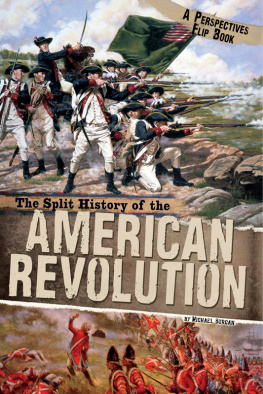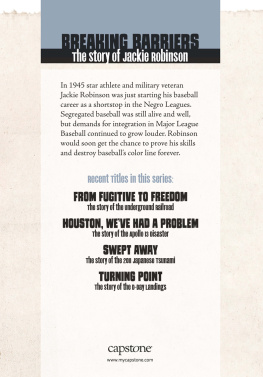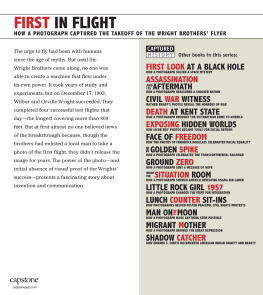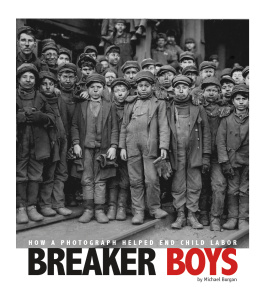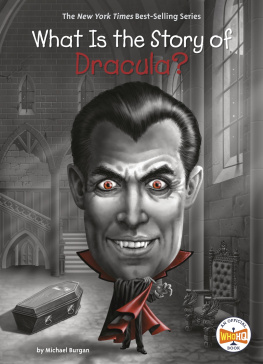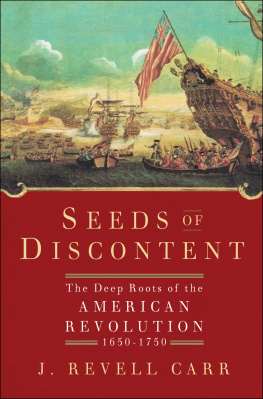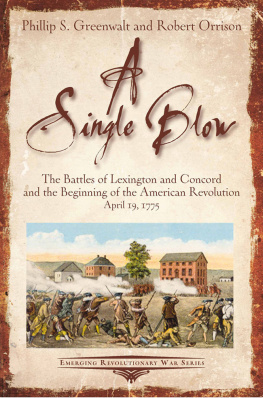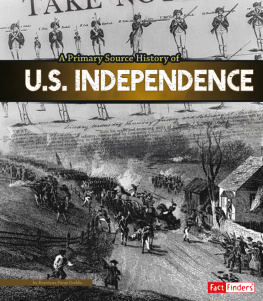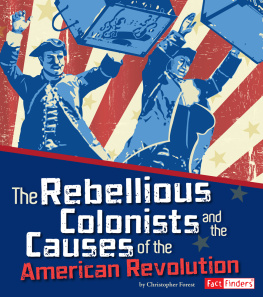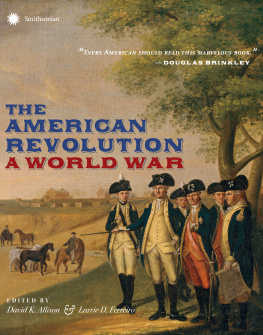Compass Point Books
1710 Roe Crest Drive
North Mankato, Minnesota 56003
www.capstonepub.com
Copyright 2013 by Compass Point Books, a Capstone imprint.
All rights reserved. No part of this publication may be reproduced without written permission of the publisher. The publisher takes no responsibility for any of the materials or methods described in this book, nor for the products thereof.
Library of Congress Cataloging-in-Publication Data
Burgan, Michael.
The split history of the American Revolution : a perspectives flip book / by Michael Burgan.
pages cm. (Perspectives flip book)
Includes bibliographical references and index.
Summary: Describes the opposing viewpoints of the British and Patriots during the American
RevolutionProvided by publisher.
ISBN 978-0-7565-4570-3 (library binding)
ISBN 978-0-7565-4592-5 (paperback)
ISBN 978-0-7565-4688-5 (e-book)
1. United StatesHistoryRevolution, 1775-1783Juvenile literature. I. Title.
E208.B94 2013
973.3dc23 2012004681
ANGIE KAELBERER, EDITOR
ASHLEE SUKER, DESIGNER
WANDA WINCH, MEDIA RESEARCHER
KATHLEEN BAXTER, LIBRARY CONSULTANT
MICHELLE BIEDSCHEID, PRODUCTION SPECIALIST
IMAGE CREDITS
Patriot Perspective:
British Perspective:
Art elements: Shutterstock: Color Symphony, paper texture, Ebtikar, flag, Sandra Cunningham, grunge photo, SvetlanaR, grunge lines
CHAPTER 1
THE ROAD TO WAR
I t was August 14, 1765. Across Boston several thousand angry people poured out into the streets. Shouts of Liberty, property, and no stamps! filled the air. The marchers were furious about the Stamp Act, a new law that taxed paper goods and documents of all kinds. That night enraged protesters burned a straw effigy of Andrew Oliver, the unlucky local official picked to collect the taxes. The mob also tore down a building Oliver owned and then headed to his home and wrecked furniture there. More destruction followed in the days to come.

Patriots protested the Stamp Act by demonstrating and hanging effigies.
The Stamp Act of 1765 was part of a new policy for the 13 American coloniesone that drove many colonists to protest British rule. Leading the fight against the policy were American colonists known as Patriots. They challenged British efforts to raise taxes and squash the colonists freedoms. The Patriots ideas and actions put the colonies and Great Britain on the road to war.
A CHANGING RELATIONSHIP
Until the 1760s Parliament and the British crown paid little attention to the distant American coloniesand most Americans liked it that way. When Parliament did pass laws that affected the colonies, the colonists sometimes ignored them. For example, they often smuggled goods they wanted from other nations instead of buying them from Britain. Colonists also elected local officials with a large degree of independence from London.
SONS OF LIBERTY
The Boston protests were led by a group of Massachusetts merchants and craftsmen called the Sons of Liberty. The group formed in Boston during the summer of 1765 and met in secret at first. Soon they numbered 2,000 men, and their protests drew much attention to the Patriot cause. By the end of 1765, Sons of Liberty groups existed in every colony.
But the relationship between the colonies and Great Britain grew tense after 1763. That year the British won the French and Indian War, in which Great Britain battled France for control of North America. Britains victory gave it control of Canada and the eastern half of what became the United States. The war had been costly, and British officials demanded that colonists help pay for the future defense of the colonies.
In 1764 Parliament passed the American Revenue Act, known as the Sugar Act, which taxed goods including sugar, wine, coffee, and some types of cloth. The Sugar Act was the first law to raise new money in the colonies. Many merchants believed the new taxes would hurt their businesses.
The Americans cherished the British tradition that gave people the right to approve the taxes they paid. They did this through the representatives they elected to Parliament or colonial legislatures. The colonies, however, had no voting representatives in Parliament. More Americans began to protest against taxation without representation.
In 1766 Parliament repealed the Stamp Act. But new taxes soon followed. The first of what came to be known as the Townshend Acts taxed glass, paint, paper, and tea imported from Britain. Some colonial merchants protested with a boycott of British goods. Boston was the center of the anger against the new laws. British officials there clamped down on smuggling. On June 10, 1768, the crew of a British warship seized a ship owned by Patriot merchant John Hancock, who was known for smuggling tea and molasses into the city. A crowd gathered to protest. Fists flew as the Americans beat up the British officials, leaving one of them bloody.
The violence in Boston led King George III to send British troops there. Soon they were camped in the heart of Boston. The residents shouted insults at the soldiers, known as Redcoats and lobster backs because of their bright red uniforms.
A MASSACRE IN BOSTON
At times citizens and soldiers fought. The worst violence came March 5, 1770. In front of the Custom House, British guard Private Hugh White was arguing with colonist Edward Garrick. Soon a crowd of angry colonists gathered in support of Garrick, hurling taunts of, bloody lobster back and lousy rascal.
The Americans didnt just toss insults at the guard on duty that cold March night. The growing crowd pelted the soldier with chunks of ice. More soldiers rushed to the scene, and the crowd threw snowballs and sticks at them. Someone shouted, Fire! and the soldiers fired their guns into the shouting mob. Three men fell dead to the ground. Two of the eight others who were wounded died later in what the Patriots called the Boston Massacre. Eight British soldiers and a captain were arrested and later tried on murder charges. All but two were acquitted.
The killings enraged some Boston Patriots, but the violence did not continue. Still, the residents hatred of the troops simmered. It wouldnt be long before it reached a boiling point.
A RIOT OVER TEA
Most colonists drank tea every day. By 1770 Parliament had abolished all of the Townshend Acts but onethe tax on tea. In May 1773, though, Parliament passed the Tea Act. The law lowered the tax on tea, but allowed only the British East India Company to sell tea in the colonies. Even though colonists would pay less for the East India tea than for smuggled tea, they viewed the Tea Act as just one more example of British attempts to control their lives.

Eleven men were shot during the Boston Massacre.
Several thousand people jammed into Bostons Old South Meeting House December 16, 1773, to discuss the fate of three loads of tea sitting in the harbor. The Patriots did not want the tea to come ashore. When it became clear the governor wouldnt let the ships leave until the tea was unloaded, Patriot leader Samuel Adams stood. he shouted.
Adams words were a signal to other Patriots in the crowd. That night dozens of men, some disguised as American Indians, boarded the ships and threw all the tea into the harbor.
In London an angry King George quickly responded to this Boston Tea Party. He had Parliament pass several laws that punished Boston and the Massachusetts colony as a whole. They included shutting down the port of Boston and limiting local control of the government. Americans called these laws the Intolerable Acts.

